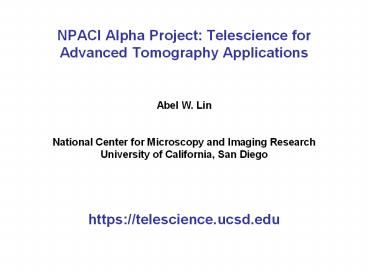NPACI Alpha Project: Telescience for Advanced Tomography Applications PowerPoint PPT Presentation
1 / 23
Title: NPACI Alpha Project: Telescience for Advanced Tomography Applications
1
NPACI Alpha Project Telescience for Advanced
Tomography Applications
Abel W. Lin National Center for Microscopy and
Imaging Research University of California, San
Diego
https//telescience.ucsd.edu
2
The Telescience Vision
A combination of several independent technologies
integrated for the application of biological
tomography in a way that fosters collaboration.
3
Testbed for the Project ? Electron Tomography
- Derive 3D information about a sample from a
series of 2D projections. - Perfect application for driving the integration
of technologies - Computation and data intensive
- Requires increased access to unique, expensive
instrumentation - Requires advanced visualization tools for
segmentation - and analysis of the data
- Detailed process well suited for collaboration
- Demand from neuroscience community for
accelerated - population of databases of biological structure
HVEM
3D Model of the Node of Ranvier
4
Grid Networked Resources enable High-Throughput
Scientific Environment
Growing data sizes require (960 MB -gt 90 GB
Volumes) require massive computational and
distributed storage resources Experiments
require multiple geographically distributed
resources
Data Computation
Data Archival
Data Acquisition
Grid Middleware is the software stack that
enables the Grid
Data Visualization
Database
Telescience Portal A web-based application
environment that extends the Grid to the user
via a single username and password
5
Telescience Portal
6
Telescience Architecture
Telescience Portal
Applications / Instruments
Java Grid Interface
GridPort ToolKit
SRB
DataCutter
Globus
NWS
NPACkage
Physical Resources
- Telescience Portal is composed of many layers
- Layers are modular, allowing for extension of
each layers with great disruption to the entire
system - Due to layered Telescience architecture,
expansion of services does not cause any Portal
downtime. New services simply appear for use.
Telescience Portal centralizes all
administrative details of each layer into a
single username and passphrase
7
Login Page
8
Telescience Portal Tomography Workflow
9
Example Data from Grid to NIH ImageJ
10
Grid Services
11
Telemicroscopy via VidCon2
12
Globus Enabled Tomography (Gtomo)
- No need to manage Globus Certificates
- Simply click resource(s) to use and enter
biological parameters - Resources are transparently cross-platform,
cross-domain - Gtomo has been launched 160 times since Aug
2002 - NCHC resources used 83 times since its
integration in Sept 2002
The Grid is abstracted away from the end user
13
Image Processing
JFido
JViewer
Pre-processing Utilities (ie. Fiducial marking,
cropping, normalization) general 2D image viewer
3D contour visualization morphological
measurements
14
NCHC Automatic - Segmentation
- Data Input / Output to SRB
- Job is initiated via Portal but computation is
on NCHC compute resource - Output Formats vrml, Open Inventor, IvI Vis
Browser
15
NCHC Surface Rendering Browser
16
Database Integration
17
SRB Collection Browser
18
(No Transcript)
19
Wireless Access
- Web based technologies lets us take advantage of
commodity technologies. - Anywhere, anytime access.
- Uniform Internet interface.
20
Telescience and Education
Sidwell Friends School Washington, DC
21
Telescience incorporated into the classroom
- Students have been collaborating with NCMIR in
San Diego using a 400,000 volt Transmission
Electron Microscope (shown at right)
A 3-D reconstruction done by a student during a
summer internship
22
Curricular Impact
- The collaboration thus far has
- Introduced students to the cyberinfrastructure
(advanced networking, computational resources,
image processing, and computer graphics) as well
as neurobiology - Expanded students understanding of microscopy
and imaging science - Provided intern opportunities
- Facilitated scientific presentations
- Involved Telescience Portal and Tomography Tools
23
Project Participants
- Telescience Participants
- Telemicroscopy and Project Integration National
Center for Microscopy and Imaging Research
(Ellisman) - Globus Information Sciences Institute,
University of Southern California (Kesselman) - GridPort San Diego Supercomputer Center (Mock)
Texas Advanced Computing Center (Thomas) - Storage Resource Broker (SRB) San Diego
Supercomputer Center (Moore, Rajasekar) - Cell-Centered Database University of California
San Diego (Martone, Gupta), Montana State
University (Jacobs) - Interactive Collaboration Environments Center
for Computational Visualization, University of
Texas (Bajaj) - Application-Level Scheduling (AppLeS) and Network
Weather Service (NWS) University of California
San Diego (Berman), University of California
Santa Barbara (Wolski) - International Collaborators
- Advanced Networking and Computation Cybermedia
Center, Osaka University, Japan (Shimojo,
Akiyama) - 3 MeV Microscopy Center for UHVEM, Osaka
University, Japan (Mori) - Visualization and Computation National Center
for High-Performance Computing (NCHC), Taiwan
(Lin) - Global Networking Collaborators
- Internet-2 Abilene IPv6 Backbone (Almes,
Corbató) 10Gigabit US Backbone - SURFnet 10Gigabit Amsterdam Network
- Tyco/IEEAF 10 Gigabit POS Lambda between US
and SURFnet - APAN/Transpac OC12 Between Pacific Northwest
Gigapop Seattle and Toyko

